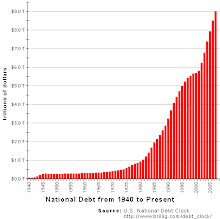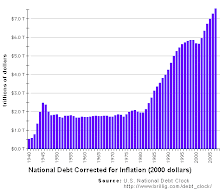Fiscal Policy – Taxation and Government Spending
Fiscal policy is the use of taxation and government spending to manage the macroeconomy by either increasing or decreasing overall spending on newly produced goods and services (i.e., aggregate demand).
Aggregate demand (AD) for domestically produced goods and services is comprised of consumption spending (C), investment spending (I), government purchases of newly produced goods and services (G), and exports of domestically produced goods and services to foreign buyers (X) minus the items in consumption (C), investment (I), and government purchases (G) that are imported from foreign producers (M). Thus,
AD = C + I + G + X – M
Expansionary fiscal policy seeks to increase overall spending (i.e., aggregate demand) by either: (a) increasing government purchases of newly produced goods and services (G), which is a direct effect, or (b) decreasing taxes to encourage more consumption (C) or investment (I) spending, which is an indirect effect because tax cuts might not result in new spending (e.g., if an individual uses the tax benefit to pay down credit card debt). It is appropriate to use expansionary fiscal policy to reduce unemployment and attempt to slow or reverse economic downturns (recessions and depressions).
Contractionary fiscal policy seeks to decrease overall spending (i.e., aggregate demand) by either: (a) decreasing government purchases of newly produced goods and services (G), which is a direct effect, or (b) increasing taxes to discourage consumption (C) or investment (I) spending, which is an indirect effect because tax increases might not result in less spending (e.g., if an individual uses a credit card to maintain consumption). It is appropriate to use contractionary fiscal policy to reduce inflation.
Fiscal policy has a political bias. Citizens like expansionary fiscal policy, but dislike contractionary fiscal policy. Because of this bias, society tends to rely more on monetary policy to manage the economy.
Taxation Principles
Efficiency – How much of a burden is imposed on society by the tax? Example: A poll tax (head tax) causes no distortions to behavior. By contrast, an income tax may reduce the incentive to work.
Equity – How fair is the tax?
Who should pay taxes?
Benefits principle – Whoever receives the benefit of the government service should pay the tax to pay for it. (e.g., fuel taxes to pay for roads and highways)
Ability-to-pay principle – People with a greater ability to pay tax should indeed pay more tax. (But how much more?)
Taxes in Relation to Income
| | | | | | | | |
| | Income | Tax Paid | % of Income | Tax Paid | % of Income | Tax Paid | % of Income |
| Lee | $25,000 | $5,000 | 20% | $6,250 | 25% | $7,500 | 30% |
| Sandy | $50,000 | $12,500 | 25% | $12,500 | 25% | $12,500 | 25% |
| Tracy | $100,000 | $30,000 | 30% | $25,000 | 25% | $20,000 | 20% |
| | | Progressive – the tax is a higher percentage of income for richer people. Example: individual income taxes (usually – but tax reforms, such as the reduction in the capital gains tax, make the tax proportional or regressive for some people). | Proportional – the tax is the same percentage of income for everyone. Example: property taxes to the extent that assessments reflect differences in income. | Regressive – the tax is a higher percentage of income for poorer people. Examples: Social Security taxes, sales taxes, most fee (driver´s license, car registration, park admission fees, sewer and water assessments.) | |||






excellent post on government
ReplyDelete